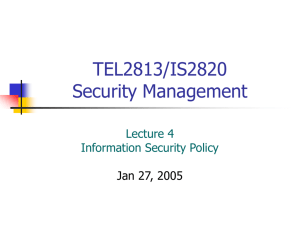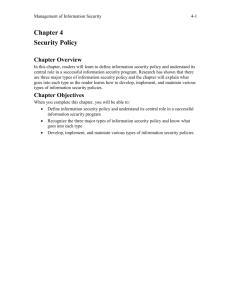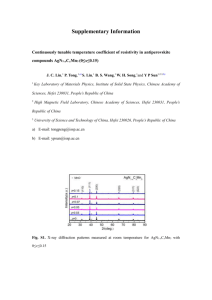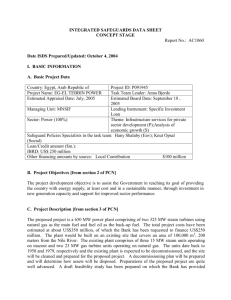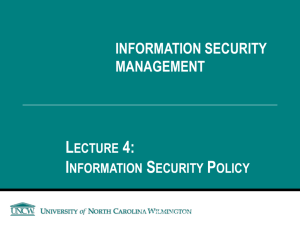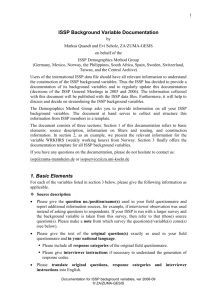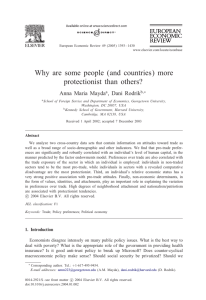Integrated Safeguards Data Sheet
advertisement
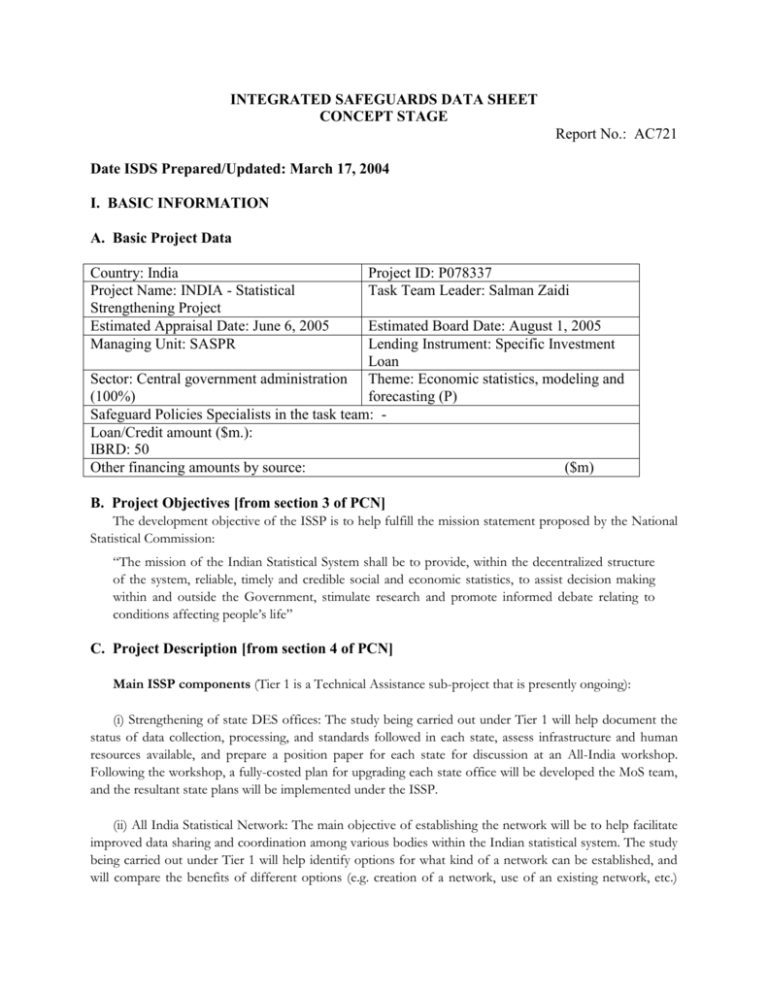
INTEGRATED SAFEGUARDS DATA SHEET CONCEPT STAGE Report No.: AC721 Date ISDS Prepared/Updated: March 17, 2004 I. BASIC INFORMATION A. Basic Project Data Country: India Project Name: INDIA - Statistical Strengthening Project Estimated Appraisal Date: June 6, 2005 Managing Unit: SASPR Project ID: P078337 Task Team Leader: Salman Zaidi Estimated Board Date: August 1, 2005 Lending Instrument: Specific Investment Loan Sector: Central government administration Theme: Economic statistics, modeling and (100%) forecasting (P) Safeguard Policies Specialists in the task team: Loan/Credit amount ($m.): IBRD: 50 Other financing amounts by source: ($m) B. Project Objectives [from section 3 of PCN] The development objective of the ISSP is to help fulfill the mission statement proposed by the National Statistical Commission: “The mission of the Indian Statistical System shall be to provide, within the decentralized structure of the system, reliable, timely and credible social and economic statistics, to assist decision making within and outside the Government, stimulate research and promote informed debate relating to conditions affecting people’s life” C. Project Description [from section 4 of PCN] Main ISSP components (Tier 1 is a Technical Assistance sub-project that is presently ongoing): (i) Strengthening of state DES offices: The study being carried out under Tier 1 will help document the status of data collection, processing, and standards followed in each state, assess infrastructure and human resources available, and prepare a position paper for each state for discussion at an All-India workshop. Following the workshop, a fully-costed plan for upgrading each state office will be developed the MoS team, and the resultant state plans will be implemented under the ISSP. (ii) All India Statistical Network: The main objective of establishing the network will be to help facilitate improved data sharing and coordination among various bodies within the Indian statistical system. The study being carried out under Tier 1 will help identify options for what kind of a network can be established, and will compare the benefits of different options (e.g. creation of a network, use of an existing network, etc.) with corresponding costs. The plan eventually selected from among these options will then be implemented under the ISSP. (iii) Business Register: Part of MoS’s long-term plans to improve the reliability of GDP estimates is the creation and progressive improvement of a business register to function as a sample frame for all enterprise surveys. The study carried out in Tier 1 will examine the feasibility of combining different administrative lists for this purpose through a pilot to be conducted in Andhra Pradesh. The All-India Business Register will be established under the ISSP based on the blueprint developed through the Tier 1 study. (iv) Improvement of service sector statistics: India’s services sector is heterogeneous as well as rapidly growing and changing in composition and character, making the development of appropriate survey methodology a major challenge. MoS plans to develop a system of periodical surveys, covering one or more sub-sectors every year through suitably designed surveys with a view to improve the availability and quality of services sector statistics, particularly in the measurement of its contribution to GDP. Small surveys covering specific segments are being taken up initially under Tier 1 to gain experience and develop appropriate systems. The survey methodology developed through initial pilot studies of selected sub-sectors will be extended to other services sub-sectors under the ISSP after suitable adjustments. (v) Statistical Consultancy Wing: Both because of government policy and because the official statistical system might not yet be equal to the task, it is important to buttress it with help from the private sector. While there are many private sector organizations engaged in data collection and related activities, relatively little information is available on their capability, area of operation, infrastructure, expertise, etc., a gap which is expected to be filled through a study presently underway under Tier 1. MoS is considering establishing a consultancy wing to cater to increasing demands for professional statistical and survey services on a fee-basis, so the Tier 1 study will also help identify statistical offices outside India that have a similar institution, and propose possible structure, powers, and functioning of an Indian version that could utilize existing private sector organizations. A statistical consultancy wing will then be set up under the ISSP. (vi) National Accounts Type Studies: MoS is working closely with the Ministries of Agriculture and Industry to improve the coverage, timeliness, and reliability of information collected in these subject areas. In addition, MoS plans to conduct several type-studies to update the various rates and ratios used in compilation of GDP estimates. These studies will be carried out in close collaboration with research institutions, state governments, and other professional bodies. (vii) Improvement of Household Surveys: The NSC has made a number of recommendations to improve the coverage and timeliness of household surveys conducted by the National Sample Survey Organization (NSSO), including improvement in sampling procedures and questionnaire design, and selection of appropriate reference periods for the various questionnaires used. These surveys are an important source of information for tracking income poverty and other MDG indicators. Under the guidance of the various Expert Groups appointed by GoI for each survey round, NSSO plans to conduct several methodological studies to improve its extensive program of household surveys. (viii) Price Statistics: Modernization activities to be carried out under the ISSP include base-year updating for the various price indices, construction of a new series of All-India consumer price indices for urban and rural areas, establishment of a databank on prices, improvement of the wholesale price index and construction of a new producer price index, and establishment of a unified price data collection system. (ix) Human Resource Development: There are currently over sixty two thousand statistical personnel working across central and state organizations. However, there is an extreme shortage of adequate training facilities for these staff, apart from a small MoS training division (which by itself is poorly equipped to service this huge demand). The ISSP will help upgrade the training infrastructure by creating a database of statistical personnel, with information on their existing qualifications, experiences, and training requirements that would help implement better staff deployment and career management practices. In addition, the ISSP will also help develop improved curricula and other resource material needed to meet the training needs of staff at the central and state level. (x) Strengthening of Organizational Structure: The NSC has recommended the establishment of a permanent and statutory National Commission on Statistics (NCS) as a policy-making body to oversee all statistical activities and ensure effective coordination. In addition, a National Statistical Organization will be established within MoS, and will comprise Directorate Generals of Statistics (replacing the present CSO) and National Sample Surveys (replacing the present NSSO), a Data Storage and Dissemination Center, and a National Center for Statistical Consultancy. The ISSP will help support this organizational restructuring; details pertaining to the various activities that this will entail will be finalized once the NCS has been established (pls. see below). D. Project location (if known) Delhi. Other state capitals where the state Directorates of Economics and Statistics are located. E. Borrower’s Institutional Capacity for Safeguard Policies [from PCN] N/A II. SAFEGUARD POLICIES THAT MIGHT APPLY [] Safeguard Policy If Applicable, How Might It Apply? Environmental Assessment (OP/BP 4.01) [] Natural Habitats (OP/BP 4.04) [] Pest Management (OP 4.09) [] Involuntary Resettlement (OP/BP 4.12) [] Indigenous Peoples (OD 4.20) [] Forests (OP/BP 4.36) [] Safety of Dams (OP/BP 4.37) [] Cultural Property (draft OP 4.11 - OPN 11.03) Applicable? [] Projects in Disputed Areas (OP/BP/GP 7.60)* [] Projects on International Waterways (OP/BP/GP 7.50) Environmental Assessment Category: [ ] A [ ] B [X] C [ ] FI [ ] TBD (to be determined) If TBD, explain determinants of classification and give steps that will be taken to determine that EA category (mandatory): III. SAFEGUARD PREPARATION PLAN A. Target date for the Quality Enhancement Review (QER), at which time the PAD-stage ISDS would be prepared. B. For simple projects that will not require a QER, the target date for preparing the PAD-stage ISDS C. Time frame for launching and completing the safeguard-related studies that may be needed. The specific studies and their timing1 should be specified in the PAD-stage ISDS. IV. APPROVALS Signed and submitted by: Task Team Leader: Approved by: Regional Safeguards Coordinator: Comments Sector Manager: Comments Salman Zaidi 17th March 2004 Pramod Agrawal 27th April 2004 Kapil Kapoor 8th April 2004 * By supporting the proposed project, the Bank does not intend to prejudice the final determination of the parties' claims on the disputed areas 1 Reminder: The Bank's Disclosure Policy requires that safeguard-related documents be disclosed before appraisal (i) at the InfoShop and (ii) in-country, at publicly accessible locations and in a form and language that are accessible to potentially affected persons.

